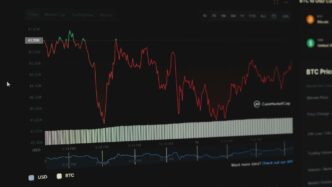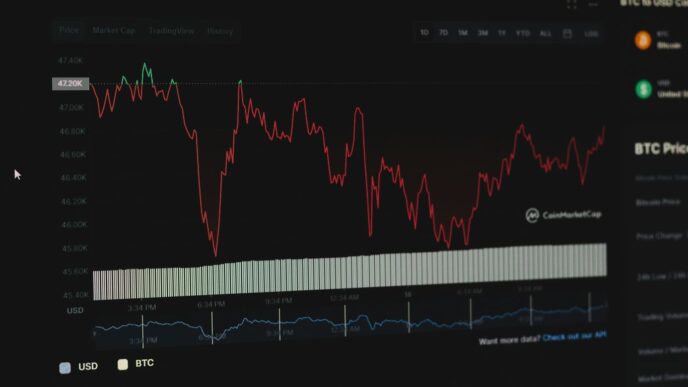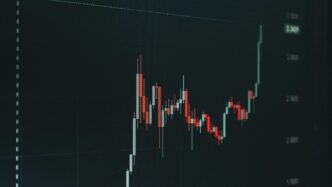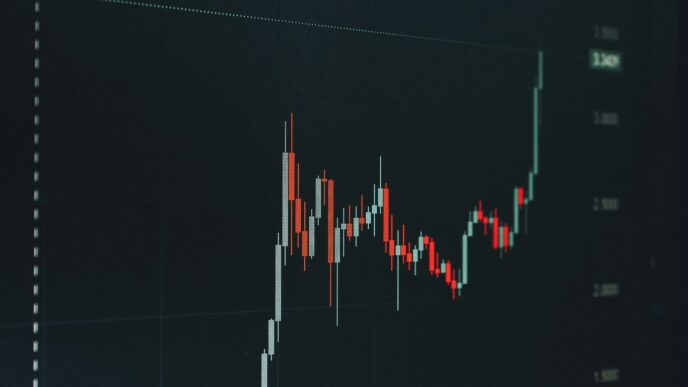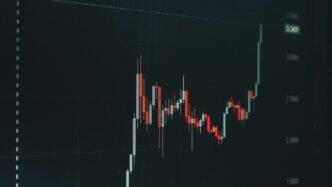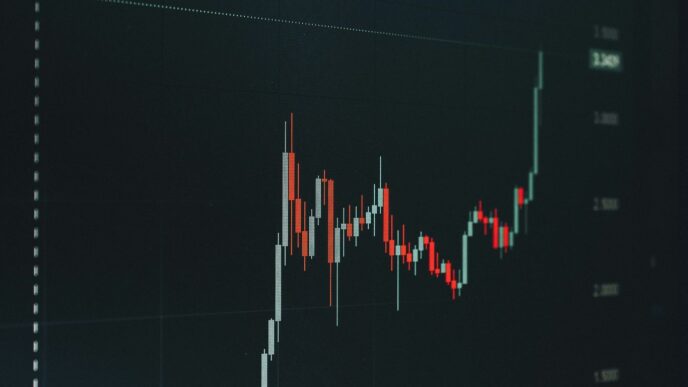So, you want to trade crypto and make some money? It sounds easy enough, right? You see people on social media showing off their wins, and it looks like a breeze. But there’s a lot more to it than just picking a coin and hoping for the best. A big part of figuring out what might happen next involves looking at charts. Learning how to read crypto charts for day trading can really make a difference. It’s like having a map for the wild crypto market, showing you potential paths and warning you about pitfalls. We’ll break down the basics so you can start making more sense of those price movements.
Key Takeaways
- Crypto chart patterns are visual shapes formed by price movements that help traders guess where prices might go. They’re a big part of technical analysis for spotting potential breakouts or trend changes.
- There are three main types of patterns: reversal patterns (spotting trend changes), continuation patterns (confirming existing moves), and bilateral patterns (signaling uncertainty).
- Don’t just rely on patterns alone. Use other tools like trading volume, momentum indicators (like RSI or MACD), and price action itself to confirm what a pattern might mean.
- When you’re starting out, stick to daily or 4-hour charts. Shorter timeframes can be too jumpy and give you bad signals. Longer charts can help you see the bigger picture.
- Always manage your risk. Use stop-loss orders to limit losses and keep your position sizes small. Protecting your money is more important than winning every single trade.
Understanding Crypto Chart Patterns For Day Trading
What Are Crypto Chart Patterns?
Think of crypto chart patterns as visual stories told by price movements on a graph. They’re formations that traders look for on things like candlestick or line charts. These shapes can give clues about where the price might go next. It’s like seeing a familiar shape in the clouds and guessing what it might turn into. For day traders, spotting these patterns can help identify potential entry or exit points, or even signal when to stay on the sidelines.
Why Chart Patterns Matter in Crypto
In the fast-paced world of crypto, prices can swing wildly. Chart patterns help traders make sense of this choppiness. They can point to areas where the price might find support (a floor) or resistance (a ceiling), or where it might break out of a current range. These patterns are essentially a way to gauge market sentiment and anticipate future price action based on historical behavior. While no pattern is a crystal ball, they can tilt the odds in your favor by providing a framework for decision-making.
The Speed and Volatility of Crypto Patterns
Here’s where crypto gets interesting – and a bit wild. Unlike traditional stock markets that close at night, crypto markets trade 24/7. This constant activity, combined with high volatility, means chart patterns can form and resolve much faster. A pattern that might take weeks to develop on a stock chart could appear over just a few days or even hours in crypto. This speed offers opportunities for quick profits but also ramps up the risk. It means traders need to be extra sharp and quick to react. It’s not uncommon for patterns to play out in a fraction of the time you might expect from other markets.
Key Chart Patterns For Day Trading Success
Alright, let’s talk about the actual shapes you’ll see on crypto charts and what they might mean for your day trading. It’s not just random squiggles; these patterns are basically a visual history of buyer and seller behavior. Think of them as recurring themes in the market’s story.
Reversal Patterns: Spotting Trend Changes
These are the patterns traders get excited about because they signal a potential shift in the market’s direction. Imagine a price has been climbing for a while, and then you see something like a ‘Head and Shoulders’ formation. This usually means the buying momentum is running out of steam, and sellers might be getting ready to take over. It’s like the market is taking a deep breath before potentially heading the other way. Other common ones include ‘Double Tops’ (looks like two peaks) and ‘Double Bottoms’ (two valleys), which also suggest a trend might be about to flip.
- Head and Shoulders: Often signals a bearish reversal after an uptrend.
- Inverse Head and Shoulders: The opposite, usually signaling a bullish reversal after a downtrend.
- Double Tops/Bottoms: Two distinct peaks or troughs at similar price levels, indicating a potential trend reversal.
- Rising/Falling Wedges: While sometimes continuation patterns, they can also signal reversals when they appear at the end of a strong trend.
Continuation Patterns: Confirming Existing Moves
These patterns suggest that whatever the price was doing before is likely to keep going after a brief pause. It’s like the market is just catching its breath before continuing its journey. Think of ‘Flags’ and ‘Pennants’ – they look like small rectangles or pennant shapes after a sharp price move, suggesting the trend will resume. ‘Triangles’ (like symmetrical or ascending/descending ones) and ‘Channels’ also fall into this category. They show a period of consolidation where buyers and sellers are in a bit of a stalemate before one side wins and the trend continues.
- Flags & Pennants: Appear after a steep price move, indicating a pause before continuation.
- Triangles (Ascending, Descending, Symmetrical): Show consolidation, with a breakout often continuing the prior trend.
- Rectangles: Price trading within a defined horizontal range, suggesting a pause before the trend resumes.
Bilateral Patterns: Signaling Uncertainty
These are the trickiest ones. Bilateral patterns, like the ‘Symmetrical Triangle’, don’t give a clear hint about which way the price will go. It’s like the market is undecided. The price action narrows between two converging trendlines, and you just have to wait to see if it breaks out upwards or downwards. The key here is to wait for confirmation, usually with a significant increase in trading volume, before jumping in. Without that confirmation, you’re essentially guessing, and in crypto, guessing can get expensive fast.
Confirming Chart Patterns With Technical Tools
So, you’ve spotted a cool-looking pattern on your crypto chart. Awesome! But here’s the thing: patterns alone can sometimes be a bit like a fortune cookie – they give you an idea, but you wouldn’t bet your life savings on it. That’s where confirmation tools come in. Think of them as your pattern’s trusty sidekick, helping to make sure it’s not just a fluke.
The Role of Trading Volume
Volume is basically the heartbeat of the market. It tells you how much trading activity is happening. When a price breaks out of a pattern, like a bullish flag or a descending triangle, you want to see that volume spike. A big jump in volume means a lot of people are jumping on board with that move, giving it more power. If a pattern breakout happens on low volume, it’s a bit like a whisper – it might not mean much and could easily fizzle out. A breakout accompanied by high trading volume is a much stronger signal that the move has conviction. It’s like seeing a crowd rush into a store; you know something’s happening.
Using Momentum Indicators
Momentum indicators are like your chart’s speedometer. They help you see how fast the price is moving and if that speed is picking up or slowing down. Tools like the Relative Strength Index (RSI) or the Moving Average Convergence Divergence (MACD) can be super helpful here. For example, if you see a bullish pattern forming, but the RSI is showing that the price is already overbought and losing steam, that pattern might not play out as expected. Conversely, if a pattern breakout coincides with momentum indicators showing increasing strength, it adds another layer of confidence. You’re looking for alignment between the pattern and the underlying momentum.
Confirmation Through Price Action
Sometimes, the best confirmation comes from the price itself. After a pattern suggests a move, watch how the price behaves immediately afterward. Did it hold above a resistance level that was just broken? Did it pull back to retest a former support level and bounce off it? This is called price action confirmation. For instance, if a Head and Shoulders pattern suggests a downtrend, and after the neckline breaks, the price continues to make lower lows and lower highs, that’s strong confirmation. It’s about seeing the market follow through on the pattern’s signal. You can explore cryptocurrency chart patterns in 2025 to see how these confirmations play out in real-time.
Choosing The Right Timeframes For Analysis
When you’re looking at crypto charts, the timeframe you pick makes a big difference in what you see. It’s like looking at a map – are you checking the whole country, a single state, or just your neighborhood? Each gives you a different perspective.
Why Shorter Timeframes Can Be Misleading
Lots of day traders like to zoom in on the really short timeframes, like the 5-minute or 15-minute charts. You see a lot of action there, and it feels like there are tons of trading opportunities popping up all the time. But here’s the thing: these short charts can be super noisy. You get a lot of small price swings that don’t really mean much in the grand scheme of things. It’s easy to get tricked by a quick move that just fizzles out. These short-term charts often show more false signals than reliable ones. You might see a pattern that looks like it’s going to break out, only for the price to reverse a few minutes later. It can lead to a lot of quick, small losses if you’re not careful.
The Balance of Daily and 4-Hour Charts
For most day traders, especially those who are still getting the hang of things, the daily (1D) and 4-hour (4H) charts offer a much better balance. These timeframes filter out a lot of that short-term noise. You get a clearer view of the bigger picture, making it easier to spot actual chart patterns that have a better chance of playing out. Think of it as looking at the weather for the next few days instead of just the next hour. You can see the general trend more easily, which helps you decide if a pattern is likely to continue or reverse. It’s about finding setups that have more conviction behind them.
When to Explore Longer Timeframes
While day trading usually focuses on shorter periods, don’t completely ignore the longer timeframes like the weekly (1W) or even monthly (1M) charts. These give you a bird’s-eye view of the market. If the weekly chart shows a strong uptrend, and you spot a bullish pattern on the 4-hour chart, that’s a much stronger signal than if the weekly trend was unclear or bearish. Longer-term patterns reflect more trading activity and commitment from traders, so they tend to be more significant. Using these longer charts helps you understand the overall market direction, which can then inform your decisions on the shorter, more active charts. It’s about making sure your short-term trades are working with the bigger trend, not against it.
Essential Risk Management Strategies

Alright, let’s talk about the stuff that actually keeps you in the game: risk management. You can have the best chart reading skills in the world, but if you don’t manage your risk, one bad trade can wipe out your whole account. It’s like building a fancy house on a shaky foundation – it’s just not going to last.
The Importance of Stop-Loss Orders
So, first up, stop-loss orders. Think of these as your safety net. You decide beforehand how much you’re willing to lose on a trade, and you set an order to automatically exit if the price hits that point. This is non-negotiable for day trading. It stops a small loss from becoming a catastrophic one. For example, if you buy a crypto at $10 and set a stop-loss at $9, you’re telling the exchange to sell it if it drops to $9. You’re out, and your loss is capped at $1 per coin. It takes the emotion out of it, which is a big deal in crypto.
Managing Position Sizing
Next, position sizing. This is about how much of your total trading capital you put into any single trade. A common rule of thumb is to risk no more than 1-2% of your account on any one trade. So, if you have a $10,000 account, you’re looking at risking only $100-$200 per trade. This means even if you have a string of losing trades – and you will, everyone does – you won’t blow up your account. It’s about survival. You can calculate your position size based on your stop-loss level and the amount you’re willing to risk. It’s a bit of math, but it’s worth it.
Here’s a quick look at how it works:
- Account Size: $10,000
- Risk Per Trade: 1% ($100)
- Entry Price: $50
- Stop-Loss Price: $48
- Risk Per Coin: $50 – $48 = $2
- Position Size: $100 (Risk Per Trade) / $2 (Risk Per Coin) = 50 coins
Capital Preservation Above All Else
Finally, and this is the big one, capital preservation. Your primary goal isn’t to get rich quick; it’s to not lose the money you have. Without capital, you can’t trade. It sounds obvious, but it’s easy to forget when you see big price swings. Stick to your plan, manage your trades, and always remember that protecting your principal is more important than chasing every single potential profit. You can find more on risk management strategies if you want to dig deeper into this.
Practical Tips For Reading Crypto Charts
Alright, so you’re looking at these crypto charts, and maybe they feel a bit like a foreign language right now. That’s totally normal. The good news is, you don’t need to be a math whiz or a seasoned Wall Street pro to get the hang of it. It’s more about building a solid approach and sticking to it.
Start With Simpler Patterns
When you’re just starting out, trying to spot every single complex pattern can feel overwhelming. Honestly, it’s like trying to learn a whole new language by memorizing a dictionary. Instead, focus on the patterns that are easier to see and tend to show up more often. Think of things like the Inverse Head and Shoulders or Falling Wedges. These are pretty common in crypto, and they usually give you a clearer signal than some of the more intricate formations. Getting good at recognizing these basic ones builds your confidence and helps you get a feel for how prices move.
Avoid Chart Clutter
This is a big one. It’s tempting to load up your chart with every indicator you can find – RSI, MACD, Bollinger Bands, you name it. But here’s the thing: too many indicators can actually confuse you more than help. They start giving you conflicting signals, and you end up paralyzed by indecision. Try to keep your chart clean and focus on just a few tools that work well together and complement the chart patterns you’re looking at. Think of it like cooking; too many spices can ruin a dish. Stick to the essentials that bring out the main flavors.
Practice With Demo Accounts
Look, nobody expects you to be perfect right out of the gate. That’s why demo accounts, or paper trading as some call it, are such a lifesaver. Most charting platforms offer this feature. It lets you practice spotting patterns and making trades using fake money. You get to see how your strategies play out in real-time market conditions without risking a single dollar of your own cash. It’s a safe space to make mistakes, learn from them, and build up your skills. Once you feel more comfortable and consistent in the demo environment, you can start transitioning to live trading with smaller amounts. It’s a smart way to build a solid foundation for the long run.
Leveraging Tools For Chart Analysis

So, you’ve been studying these chart patterns, right? It’s like learning a new language, and honestly, it can feel a bit overwhelming at first. But here’s the thing: you don’t have to go it alone. There are some seriously helpful tools out there that can make reading crypto charts way easier and, dare I say, more effective.
Advanced Charting Platforms
Forget those basic charts you see on some sites. For real analysis, you need a platform that gives you options. Think TradingView, for example. It’s packed with indicators, drawing tools, and a whole community of traders sharing their ideas. Most major crypto exchanges also have their own charting tools built-in, like those on Binance or Coinbase. They’re okay for a quick look, but if you’re serious about digging deep, a dedicated platform is the way to go. These platforms let you see price action in detail, which is pretty important when you’re trying to spot those subtle patterns. You can find a lot of these tools at places like Cryptowat.ch.
Utilizing Market Data Resources
Patterns are great, but they don’t exist in a vacuum. You need to back them up with solid data. This is where things like trading volume come in. A pattern breakout that happens with a big spike in volume? That’s usually a much stronger signal than one with barely any trading activity. It’s like the market is shouting its agreement. You can also look at momentum indicators, like the RSI or MACD. These help show if a price move has the energy to keep going or if it’s about to fizzle out. Basically, you’re looking for confirmation from multiple angles before you jump into a trade. It’s about building a case, not just guessing.
Integrating News and Sentiment Analysis
And then there’s the news and general market mood. Crypto is super sensitive to what’s happening in the world, and sometimes, a big news event can completely blow up a perfectly formed chart pattern. So, keeping an eye on major announcements, regulatory news, or even just the general buzz on social media can give you a heads-up. Some platforms even try to gauge market sentiment, which can be another piece of the puzzle. It’s not just about the lines on the chart; it’s about understanding the forces driving the price. Combining technical signals with an awareness of the broader market narrative is key to making smarter trading decisions.
Here’s a quick rundown of what to look for:
- Volume Spikes: Look for increased trading volume during breakouts or significant pattern formations.
- Indicator Alignment: Check if momentum indicators (RSI, MACD) support the price action suggested by the pattern.
- News Events: Be aware of upcoming economic data releases or crypto-specific news that could impact prices.
- Sentiment Shifts: Monitor social media and news outlets for changes in overall market mood.
Wrapping It Up
So, we’ve gone over how to read crypto charts and spot those patterns. It’s not magic, really. It’s more about looking at what prices have done before and making an educated guess about what might happen next. Remember, these patterns aren’t crystal balls; they just give you better odds. Always pair them with other tools like volume and, most importantly, manage your money like it’s precious. Don’t bet the farm on any single trade. Keep practicing, learn from your wins and losses, and you’ll get better at this. It takes time, but sticking with it can really make a difference in your trading game.
Frequently Asked Questions
Are crypto charts the same as stock charts?
Pretty much! The basic idea of looking at price movements on a chart is the same whether it’s crypto, stocks, or even foreign currency. But crypto markets are open 24/7 and can swing wildly much faster than stocks. So, patterns might form and finish quicker in crypto.
Which chart patterns are best for crypto?
Patterns that look clear and have strong volume backing them up tend to work well. Think of things like ‘inverse head and shoulders’ or ‘falling wedges.’ These have often proven reliable for big cryptos like Bitcoin. More complicated patterns need more practice.
How do I know if a pattern is really working?
You need to see the price break out of the pattern clearly, and it helps a lot if there’s more trading activity (volume) at that moment. Tools like the RSI can also give you extra confidence, but the price action and volume are the main clues.
Can I just use chart patterns to make money?
Chart patterns are like hints, not guarantees. They help make your chances better, but they don’t promise a win. You should always use them with other analysis, like checking the overall market trend, and most importantly, managing your money carefully.
What’s the best time to look at for crypto charts?
For beginners, the 1-day and 4-hour charts are a good middle ground. Super short charts (like 5-minute) can be confusing with lots of fake signals. Longer charts might be too slow if you’re actively learning. The 1D and 4H charts show clearer trends.
How reliable are crypto chart patterns?
It varies! Some patterns, like inverse head and shoulders, have a pretty good success rate if they’re confirmed. Others might only work out about half the time. That’s why using stop-loss orders is super important to protect yourself when a pattern doesn’t go as planned.





